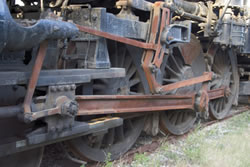BUSINESS
Inside SCV History
Changing Industry and Broken Dams Mark the Early Part of the Century
May, 2006 - Issue #19
 |
As times grew tougher after the death of Henry, the company began to look at alternative sources of revenue to keep the company afloat. It was in this context that oil and water surveys began to look at future potential. There was also an attempt to sell some of the more distant properties, but a national economic downturn depressed the markets.
However, all things were not in shambles. In 1887, a rail line to the coast was completed by Southern Pacific. Intersecting the north-south line running through Newhall, the spur joined at the site of the original train station. For the first time, the name Saugus (Henry's hometown in Massachusetts) was suggested for the juncture.
During Henry Junior's control of the company, mass debts had accumulated; however, two younger brothers, Edwin and Walter, had been more successful. Their stakes included a real estate venture in Downtown Los Angeles centered around their "Angel's Flight" railway. It was at this same time that an orchard began along what would be come Highway 126.
Rancho Camulos (now a California Historical Site in Ventura County about 15 minutes west of the I-5) had been a functioning farm for years with hundreds of fruit trees and 60,000 vines of grapes. Building just east of the Del Valle's Rancho Camulos, Mayo Newhall, a son of Henry's, first conducted a water survey along the Santa Clara River. Differing from our current situation, both Newhall and Del Valle agreed there was plenty of water for both farms and the next year began the planting of acres and acres of citrus trees that would become the foundation for the vast industry to come.
During the early 20th century, little had changed in the first 25 years of the company. Oil wells were still dry. Gold was discovered at Placerita Canyon a half-century earlier but nothing significant had resulted. Cattle were still the main source of income along with the occasional mineral lease.
Some land was sold off near San Francisco just before the San Francisco earthquake, which destroyed the Newhall corporate offices downtown but spared Edwin's ocean view home. For the next few months, this would double as the company's offices. Problems continued as war-time profits could barely keep pace with rising taxes, including the newly instated income tax. Seeking an additional revenue source, the Newhall Company sold a portion of their Piojo Ranch along the central California coast. The neighboring property owner, a Mr. William Randolph Hearst, was looking to expand his huge estate outside San Simeon.
Unlike other huge land ranches across the state which resisted any intrusion, the Newhall properties welcomed public utilities. With the railroad, the Los Angeles aqueduct and later Route 99 and Interstate 5, came tremendous opportunity - but with these opportunities came great risk.
Early in the morning of March 12, 1928, the San Francisquito Canyon Dam, which served as a reservoir on the Los Angles aqueduct project, burst. The broken dam sent a wall of water, in some areas 60-feet tall, through the Santa Clarita Valley, past Fillmore and Ventura, to the Pacific Ocean. Over 11.2 billion gallons of water poured across the Newhall Ranch. Without warning, over 400 people perished. With only minutes of notice, a heroic effort spared some lives closer to Ventura but hundreds of square miles of property were utterly destroyed. All farm land was covered in sand. Well over 1,000 homes were washed away. Railroads, irrigation canals, orchards, and roads were completely gone. The city of Los Angeles took full responsibility for the disaster as the owner and contractor for the dam. Damages totaled over $15,000,000, the largest property claim in state history. But before the money could restore the vitality to the Newhall Company, the Great Depression would further devastate our local valley.
--------------------------------------------------------------
Much of research for this article came from "A California Legend: the Newhall Land and Farming Company" by Ruth Waldo Newhall. The book is highly recommended to everyone interested in the history of our valley.
|
||||||||||||||||||||||||||||





